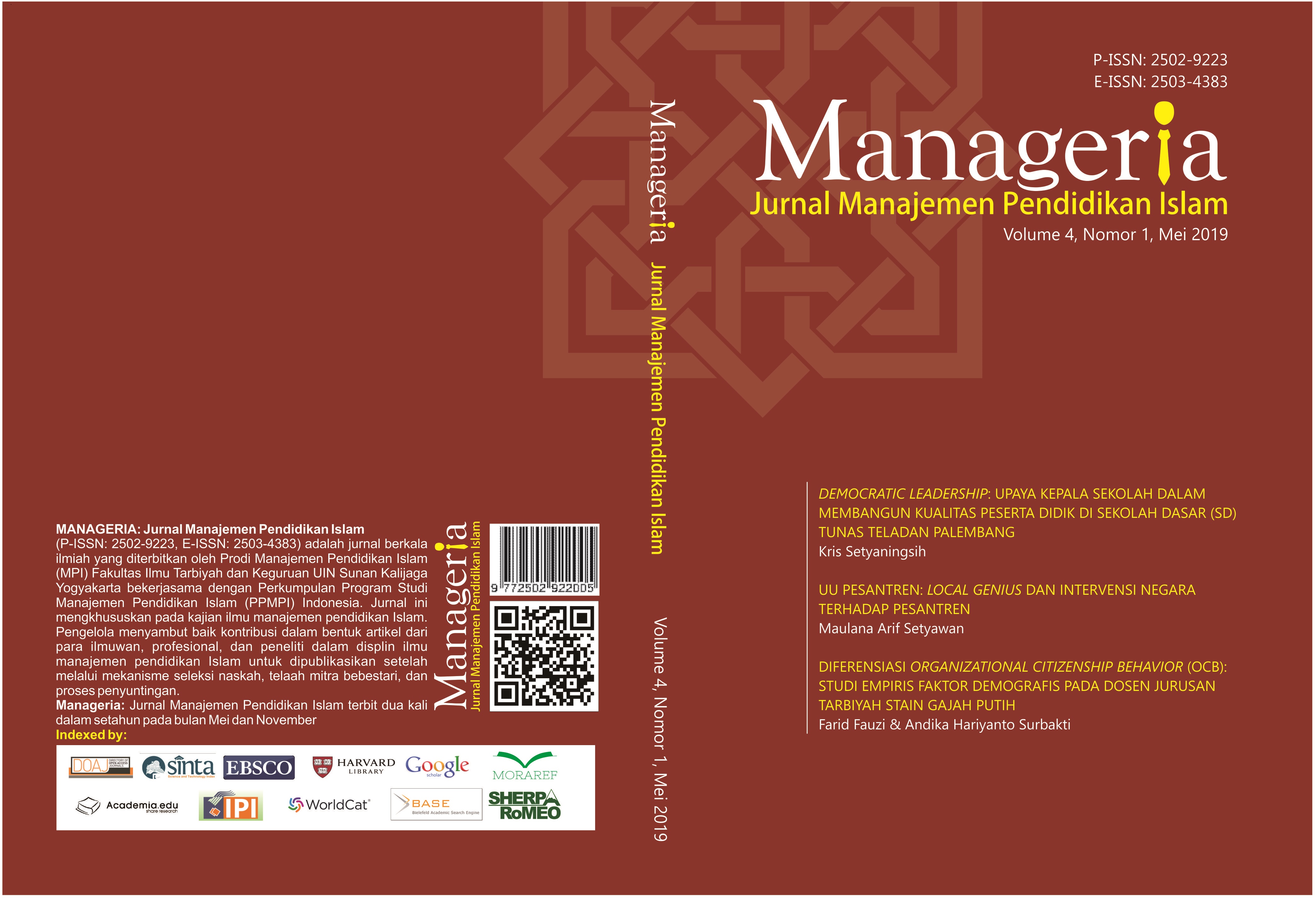Analisis PIECES dalam Implementasi Kebijakan E-Learning di IAIN Kendari
DOI:
https://doi.org/10.14421/manageria.2019.41-07Keywords:
PIECES Analysis, Implementation, Policy, E-LearningAbstract
This study aims to analyze the implementation of e-learning policies at IAIN Kendari. Using a qualitative descriptive method, the data was collected through observation at the online page of https://elearning.iainkendari.ac.id, interviews and documentation. The results of PIECES analysis calculations in the application of e-learning are seen from several aspects, including: performance, information, economy, control and services are in the category of important with the value of 3.46%, 3.82%, 3.77%, 3.85% and 3.88% respectively. Regarding the aspect of efficiency, the value is 4.28% within the category Very Important. Whereas, the implementation of e-learning learning policies using Edward's theory was investigated from four aspects, namely: 1) communication that was conducted through the socialization of e-learning workshops; 2) resources including human/technician resources that were still very lacking as well as infrastructure with the addition of 80 Mbps bandwidth to five faculties, rectorates, libraries and postgraduate programs; 3) dispositions were given to the policy users, namely lecturers who were still less motivated in using e-learning, and 4) bureaucratic structure related to operational standards procedures that was designed in the form of e-learning guidebooks. The result found that e-learning implementation was in the category of important in the aspect of performance, information, economics, control and service, and in the category of very important in the aspect of efficiency. E-learning system at IAIN Kendari is acceptable for all academic civity, however they need personal motivation to implement and utilize it for classroom learning supported by speed internet access.
Downloads
References
AG., Subarsono. Analisis Kebijakan Publik. Yogyakarta: Pustaka Pelajar, 2011.
Anisimova, Tatyana Ivanovna, dan Lyubov Alekseevna Krasnova. “Interactive Technologies in Electronic Educational Resources.” International Education Studies Canadian Center of Science and Education 8, no. 2 (2015): 186–94.
Daryanto. Media Pembelajaran Perananya Sangat Penting Dalam Mencapai Tujuan Pembelajaran. Yogyakarta: Gava Media, 2013.
Dwiyanto, dan Indiahono. Perbandingan Administrasi Publik. Yogyakarta: Gava Media, 2009.
Fatah, Nanang. Analisis Kebijakan Pendidikan. Bandung: Remaja Rosdakarya, 2013.
Inayatulloh. “Pembangunan Model E-Learning di Perguruan Tinggi dengan Mempertimbangkan Faktor Kebutuhan Dinamis.” ComTech, Bina Nusantara University 3, no. 1 (2012): 346–53.
Kebritchi, Mansureh, Angie Lipschuetz, dan Lilia Santiague. “Issues and Challenges for Teaching Successful Online Courses in Higher Education: A Literature Review.” Journal of Educational Technology Systems 46, no. 1 (2017): 4–29. doi:10.1177/0047239516661713.
Munadi, Muhammad, dan Barnawi. Kebijakan Publik di Bidang Pendidikan. Yogyakarta: Ar-Ruzz Media, 2011.
Munir. Pembelajaran Jarak Jauh Berbasis Teknologi Informasi dan Komunikasi. Bandung: Alfabeta, 2009.
Naidu, Som. E-Learning. A Guide of Principles, Procedures and Practises. 2nd Revised., 2006. http://213.55.83.214:8181/Education/30521.pdf.
Napitulu, Darmawan. “Kesiapan Implementasi Sistem E-Learning dilingkungan Universitas XYZ.” dalam Seminar Nasional Technopreneurship dan Alih Teknologi, Pusat Inovasi LIPI, 64–72. Jakarta, 2016.
Panduan Model Pembelajaran Pendidikan Jarak Jauh di Perguruan Tinggi Kementerian Pendidikan Nasional Direktorat Pendidikan Tinggi Direktorat Pembelajaran dan Kemahasiswaan, 2011.
Peraturan Pemerintah Republik Indonesia Nomor 17 Tahun 2010 Tentang Pengelolaan dan Penyelenggaraan Pendidikan (2010).
Permendikbud Nomor 65 Tahun 2013 Tentang Standar Proses Pendidikan Dasar dan Menengah (2013).
Poluan, Frincy, Arie Lumenta, dan Alicia Sinsuw. “Evaluasi Implementasi Sistem E-Learning Menggunakan Model Evaluasi HOT FIT di Universitas Sam Ratulangi.” E-Journal Teknik Informatika 4, no. 2 (2014).
Prawiradilaga, Dewi Salma, dan Eveline Siregar. Mozaik Teknologi Pendidikan: E-Learning. Jakarta: PT Fajar Interpratama Mandiri, 2013.
Ragil, dan Wukil. Pedoman Sosialisai Prosedur Operasi Standar. Jakarta: Mitra Wacana Media, 2010.
Rusman. Pembelajaran Berbasis Teknologi Informasi dan Komunikasi. Jakarta: Rajawali Press, 2011.
Shurygin, Viktor Yurjevich, dan Lyubov Alekseevna Krasnova. “Electronic Learning Courses as A Means to Activate Students’ Independent Work in Studying.” International Journal of Environmental & Science Education 11, no. 8 (2016): 1743–51.
Solichin, Mujianto. “Implementasi Kebijakan Pendidikan dan Peran Birokrasi.” Religi: Jurnal Studi Islam, Fakultas Agama Islam Universitas Pesantren Tinggi Darul Ulum (Unipdu) 6, no. 2 (2015): 148–78.
Sudiyono. Dari Formulasi ke Implementasi Kebijakan Pendidikan. Yogyakarta: FIP UNY, 2007.
Sugiyono. Metodologi Penelitian Kuantitatif, Kualitatif dan R&D. Bandung: Alfabeta, 2013.
Tilaar, H.A.R. Kekuasaan dan Pendidikan: Manajemen Pendidikan Nasional dalam Pusaran Kekuasaan. Jakarta: Rineka Cipta, 2009.
Wahyuni, Yunita Tri. “Implementasi E-Learning Pada Mata Pelajaran Pendidikan Pancasila dan Kewarganegaraan Kelas XI di SMA Negeri 1 Yogyakarta.” Jurnal Pendidikan Kewarganegaraan dan Hukum, 2017.
Website traffic statistics and analysis. Diakses 16 Agustus 2018. http//www.alexa.com.
Wijaya, Harma Oktafia Lingga. “Implementasi Metode Pieces Pada Analisis Website Kantor Penanaman Modal Kota Lubuklinggau.” JUSIM (Jurnal Sistem Informasi Musirawas) Prodi Sistem Informasi STMIK Musirawas Lubuklinggau 3, no. 1 (Juni 2018).
Yaniawati, Poppy. E-Learning dan Alternatif Pembelajaran Kontemporer. Bandung: Arfino Raya, 2010.
Downloads
Published
Issue
Section
License
Copyright Notice
Authors who publish with this journal agree to the following terms:
- Authors retain copyright and grant the journal right of first publication with the work simultaneously licensed under a Creative Commons Attribution-ShareAlike 4.0 International License that allows others to copy and redistribute the material in any medium or format with an acknowledgement of the work's authorship and initial publication in this journal and also allows to remix, transform, and build upon the material for any purpose, even commercially with contributions under the same license as the original.
- Authors are able to enter into separate, additional contractual arrangements for the non-exclusive distribution of the journal's published version of the work (e.g., post it to an institutional repository or publish it in a book), with an acknowledgement of its initial publication in this journal.
- Authors are permitted and encouraged to post their work online (e.g., in institutional repositories or on their website) prior to and during the submission process, as it can lead to productive exchanges, as well as earlier and greater citation of published work.









.jpg)




